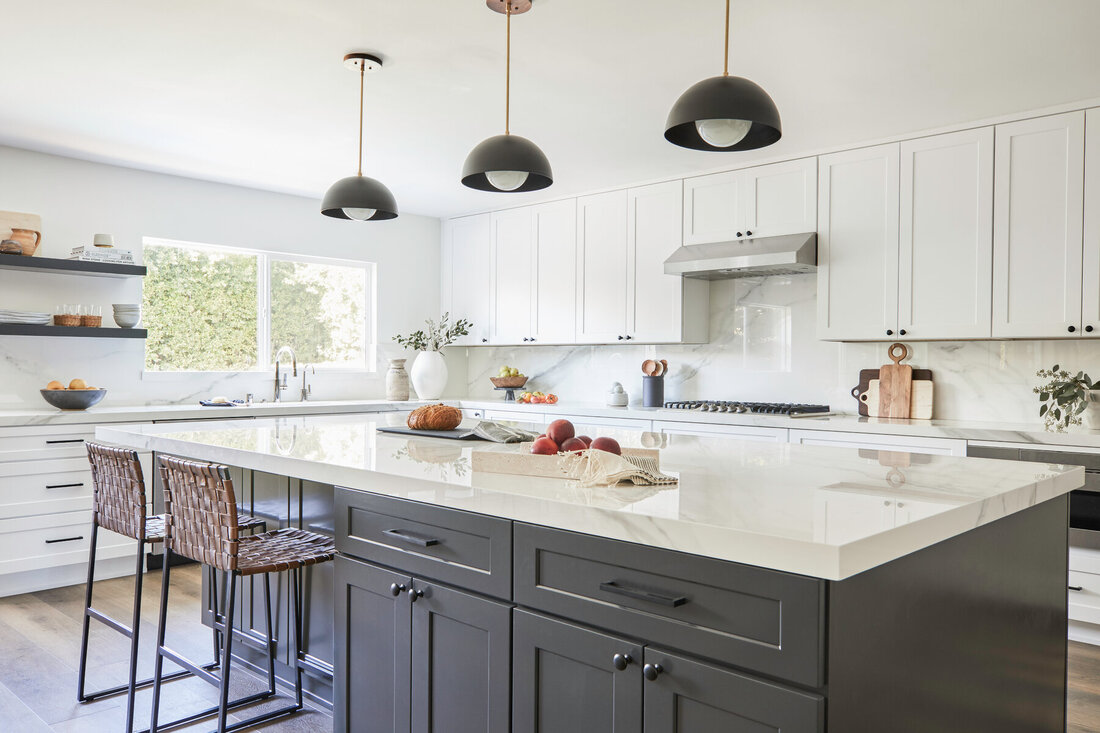VINA CABINETRY
|
Why Build a Kitchen Island? First, kitchen island cabinet work. Because they can be accessed from all sides like the old kitchen table, they're ideal for a variety of kitchen tasks. Second, these freestanding pieces instantly become the focal point of a kitchen because they can have the look and feel of furniture rather than components in a domestic laboratory. Third, islands help kitchens adjust to some of the big changes in American life in the past few decades. In June Cleaver's 1950s kitchen, all the appliances and cabinets were tacked to the walls of a closed-in room. Today's kitchens are not only open to other rooms but they also have to accommodate multiple cooks, kids doing homework, and even party guests. A well-designed island offers a place for people to congregate while at the same time separating those who are cooking and cleaning from those who are just hanging out. When planning an island with kitchen cabinets, here are the key points to consider. Uses for a Kitchen
IslandIslands have to work to make them earn the space they occupy. Here are the four things islands can do and some design suggestions for each function. Cleanup
Size and Placement Kitchen islands suck space. At minimum, an island should be 4 feet long and a little more than 2 feet deep, but it must also have room for people to move and work around it. Unless your kitchen is at least 8 feet deep and more than 12 feet long, don't even think about an island. Lighting Where you have activity, you need light. For islands, that means dedicated lighting—you can’t count on ambient light to illuminate your workspace, and you don’t have upper kitchen cabinets to hide task lights, as you do elsewhere in the kitchen. As with most task lighting, you want the light to come straight down onto the island. The most common choice is recessed lighting, which is relatively easy if you have standard-height ceilings but trickier with high ceilings. If the distance from the countertop to the ceiling is greater than 6 feet, you’ll need to use fixtures or bulbs specially designed to project light down rather than spread it out. Pendant Lighting Another option is pendant lights, which hang from the ceiling. Be careful with these, though. It’s easy to end up with them at the wrong height, which can either block your view from the island or blind you with a high-intensity bulb shining directly into your eyes. Whatever type of lighting you choose, make sure it can be dimmed when you don’t need maximum illumination for working. Storage Space You can gain valuable real estate on both the "working" side and the "public" side of an island kitchen cabinet for storage, always a critical need in kitchens. On the public side, take advantage of shallow cabinets (installed back-to-back, with deeper kitchen cabinets ) for serving items—napkins, cutlery, platters, etc.—that don't need to be in the food prep area. On the working side, make sure there's room to store the things that are needed for the activity the island supports, because an island's strong suit is also its biggest downfall: It's isolated. If it's a cooking island, then pots, pans, and spices should be at hand. The space under cooktops is great for deep drawers for pots and pans. (The temptation is to hang them from an expensive pot rack, which won't hold deeper pots or lids and gets in the way of your view.) If it's a prep island, don't forget storage for knives and small appliances like mixers and food processors (consider pop-ups — platforms that swing out from behind a door in the island base—or appliance garages for these), and convenient access to garbage and compost bins. If the island is going to be dedicated to cleanup, you'll need a place for dish towels, detergent, and brushes. Undercounter storage space is limited on islands that include a sink and/or major appliances like a dishwasher or oven; you'll have to plan more carefully for those. The same is true for cooktops with downdraft fans, the machinery for which must be stored in the cabinet below. One way around this is to use the ends of the island. Round ends are perfect for lazy Susans, and almost any island end can accommodate open shelving or even a shallow cabinet. Vent Hood Life would be a lot easier if you could just ignore ventilating an island dedicated to cooking — but you can't. The most common scheme is to install a downdraft fan behind the cooktop; in some cooktops and ranges it's incorporated into the appliance. That solves the visual problem of an overhead hood messing up sight lines. But even the best downdraft fan is not up to the worst cooking odors. If you really want to lose the fried fish smell, include a second exhaust fan mounted in the ceiling. It will also help limit the amount of moisture condensing on the inside of your windows in the winter when you use a tall stockpot. The other option is an overhead hood that extends up through the ceiling. Because it's exposed on all sides, it must be completely finished (read expensive), and it becomes a dominant element of the design. You can opt for manufactured versions, or get a hood custom-built and finished in just about any material. The big caution here: It's easy for the mass of a hood, placed low enough to be effective, to ruin the joy of having open space above the island. Counter Height Dual-height islands can create informal eating areas, hide dirty dishes, protect noncooks from splashes and splatters, and make kitchens more interesting. The height of your island's eating area dictates the type of seating you'll have: A 28- to 30-inch-high counter works best with a chair; a standard-height 36-inch counter is served best by a low stool; and a 42- to 48-inch counter requires a bar stool. Styles for Kitchen Islands You can make an island nearly disappear to anyone not working in the kitchen by extending the "public" face of the island (the one that doesn't face the kitchen) 4 to 6 inches above the countertop and covering it in the same surface material as the rest of the interior walls. Islands that mimic the rest of the kitchen, typically by using cabinets in the same finish and from the same manufacturer, don't call attention to themselves. Most islands in American kitchens use this scheme. Comments are closed.
|
Archives
May 2024
Categories |



 RSS Feed
RSS Feed
